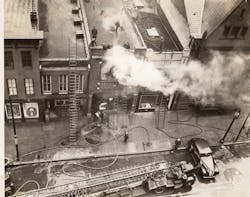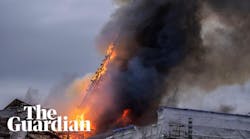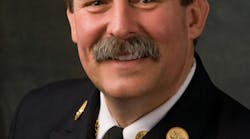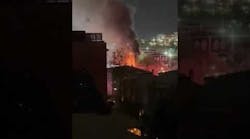JERSEY CITY, NJ: OCT. 3, 1914 – A huge explosion in the Detwiller & Street Fireworks Manufacturing Co. on West Side Avenue shook the city, killing four people, injuring 50 and leveling eight buildings. The explosion occurred inside one of three wood-frame buildings set back from the main building and used for drying the explosive composition used in making firecrackers. Arriving police and firemen found the three buildings in ruins and in flames. Nearby, three other wood-frame buildings and two brick storerooms were also demolished. The entire neighborhood was in an uproar as the fire was quickly doused and the search for those trapped in the rubble began.
HACKENSACK, NJ: OCT. 3, 1914 – An early-morning fire in the Hackensack Meadows caused heavy smoke to hang low across the area. Seriously affected was the nearby trolley track that ran adjacent to the fire area. The smoke apparently limited visibility to inches, thus causing a collision between two trolley cars using the same track. Several people were injured in the crash. Motormen later stated the smoke was so thick they could not even see the signals.
BRONX, NY: OCT. 5, 1914 – Almost a million board feet of lumber piled inside the West Farms Lumber Co. at West Farms Road and 174th Street burned fiercely during the late-night hours. Flames also ignited and destroyed the firm’s two-story brick building adjacent to the stored lumber. Inside, on the second floor lived the night watchman and his wife. He lowered her to safety before jumping out the window with their pet dog in his arms. Responding firemen struggled to battle the fire and had to stretch their lines across the Bronx River. Burning electrical poles and wires plunged the entire neighborhood into darkness as the burning wires fell to the ground. Several firemen had a close call when their hook-and-ladder truck’s team of horses became unmanageable, sending the rig into a fire hydrant. Luckily, there were no serious injuries.
NEW YORK CITY: OCT. 10, 1914 – An early morning fire swept the huge, million-dollar building in the center of the Columbia University campus in Manhattan. The building housed the University Commons, gymnasium, power plant, several executive offices of the college and the offices of the National Commission of Labor. Students meeting nearby noticed the flames and saved several athletic trophies, but were driven back by the mounting flames. Faced with a large body of fire that was extending rapidly, Chief John Kenlon quickly sent in four alarms. Firemen battled the flames, thick smoke and heavy iron gates surrounding the building. With heavy fire on all the upper floors and the fire eating its way downward toward the power plant and dynamos, the chief sent a crew into the sub-cellar to prevent a feared explosion. The difficult blaze was battled for hours, and despite the loss of all the upper floors, it was checked before it reached the power plant.
NORWICH, NY: OCT. 14, 1914 – An early morning fire caused a thick smoke condition to develop outside a grocery company building on the west side of North Broad Street. Heavy smoke rolled from the windows until suddenly a sheet of flame erupted, igniting the adjacent structures on both sides. Several persons were trapped briefly, but managed to escape. At its height, the fire threatened to sweep the entire business district, but aggressive firefighting slowed the spreading flames. Early in the battle, one of the two fire department steam engines burst a flue, placing it out of commission. Water pressure, however, remained adequate and firemen contained the spreading fire. In all, four blocks were destroyed by the fire and several firemen suffered minor injuries as damaged walls and timbers collapsed.
JERSEY CITY, NJ: OCT. 24, 1914 – A blaze, believed to have started by an electrical short circuit, was spotted by two letter carriers beginning their rounds. One ran to turn in the alarm as the second woke the pastor and his family. When firemen arrived, the church interior was like a huge furnace, and second and third alarms were quickly sent in. After three hours, the flames were finally extinguished and a salvage operation was begun. The alter cross was found untouched by the flames, but everything else of value was destroyed.
EAST SAN PEDRO, CA: OCT. 26, 1914 – Flames discovered in the Crescent Wharf and Warehouse quickly spread to a nearby sardine cannery, a billiard hall, a restaurant and the post office. The town’s seven paid firemen and 12 call-men were stretched thin and called for help from the Los Angeles Fire Department. Two pumpers were sent, but the damage was already done upon their arrival.






